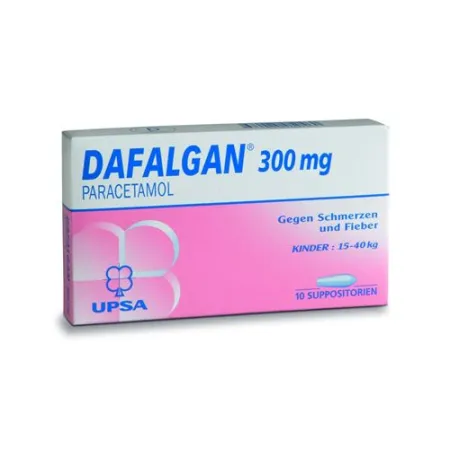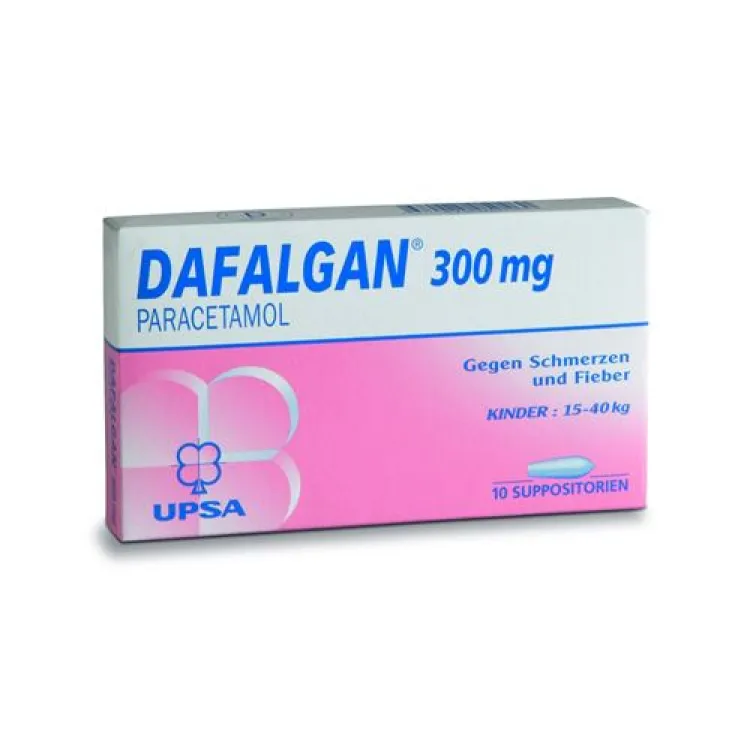Dafalgan Supp 300 mg 10 pcs
Dafalgan Supp 300 mg 10 Stk
-
6.11 USD

- Availability: In stock
- Distributor: BRISTOL-MYERS
- Brand: Dafalgan
- Product Code: 1498918
- ATC-code N02BE01
- EAN 7680475050460
Ingredients:
Description
Dafalgan suppositories contain the active ingredient paracetamol, which has an analgesic and fever-reducing effect.
Dafalgan suppositories are used for the short-term treatment of headaches, toothaches, joint and ligament pain, back pain, menstrual pain, pain after injuries (e.g. sports injuries), pain associated with colds and fever.
Swissmedic-approved patient information
DAFALGAN® suppositories
What is Dafalgan and when is it used?
Dafalgan Suppositories contain the active ingredient paracetamol, which has an analgesic and fever-reducing effect.
Dafalgan suppositories are used for the short-term treatment of headaches, toothaches, joint and ligament pain, back pain, menstrual pain, pain after injuries (e.g. sports injuries), pain associated with colds and fever.
When must Dafalgan not be used?
Dafalgan must not be used in the following cases:
- In case of hypersensitivity to the active ingredient paracetamol or another ingredient (see "What is in Dafalgan suppositories?"). Such hypersensitivity manifests itself, for example, in asthma, shortness of breath, circulatory problems, low blood pressure, swelling of the skin and mucous membranes or skin rashes (hives);
- This medicine contains soya lecithin. It must not be used if you are hypersensitive (allergic) to peanut or soya.
- For severe liver disease;
- If you have a hereditary liver disorder (so-called Meulengracht disease).
When should you be careful when using Dafalgan?
If you have kidney or liver diseases or if you have a "glucose-6-phosphate dehydrogenase deficiency" (rare hereditary disease of the red blood cells), you should consult your doctor before use.
Also tell your doctor if you are also taking blood-thinning medicines or certain medicines used to treat tuberculosis (rifampicin, isoniazid), epilepsy (phenytoin, carbamazepine), gout (probenecid), high blood fat levels (cholestyramine) or HIV- infections (zidovudine). Caution is also required when using drugs containing the active ingredients chloramphenicol, salicylamide or phenobarbital at the same time.
Your doctor must also be informed if you are using an antibiotic with the active substance flucloxacillin at the same time, as there is an increased risk of acidification of the blood (metabolic acidosis with increased anion gap). Close medical monitoring is recommended to detect the onset of metabolic acidosis.
Alcohol consumption is not recommended during treatment with Dafalgan. The risk of liver damage increases, especially if you do not eat at the same time.
Medicines containing the active substance paracetamol must not be given to children who have accidentally consumed alcohol.
Dafalgan should be used with caution in the case of eating disorders such as anorexia, bulimia and severe emaciation, as well as chronic malnutrition.
Diafalgan should be used with caution in the event of dehydration and reduced blood levels. If you have a severe infection (e.g. blood poisoning), caution should also be exercised when using Dafalgan.
Individuals who are hypersensitive to painkillers or antirheumatic drugs may also be hypersensitive to paracetamol (see «What side effects can Dafalgan have?»).
It is also important to remember that long-term, frequent use of painkillers can itself contribute to headaches developing or making existing headaches worse. In such cases, contact your doctor. Long-term use of painkillers, especially when several painkillers are combined, can lead to permanent kidney damage with the risk of kidney failure.
To avoid the risk of overdose, it should be ensured that other medications administered do not contain paracetamol. Tell your doctor, pharmacist or druggist if you
- suffer from other illnesses,
- have allergies or
- take other medicines (including those you bought yourself!) or use them externally!
Can Dafalgan be used during pregnancy or while breastfeeding?
As a precaution, you should avoid taking medicines during pregnancy and breastfeeding, or consult a doctor, pharmacist or druggist or the Ask your doctor, pharmacist or druggist for advice.
If necessary, Dafalgan suppositories can be used during pregnancy. Based on previous experience, currently with short-term use of the active substance paracetamol in the specified dosage, the risk for the child is considered low. You should use the lowest dose that relieves your pain and/or fever and you should use the medicine for the shortest possible time. Contact your doctor, pharmacist or druggist if the pain and/or fever does not improve or you need to take the medicine more often.
Although the use of paracetamol is considered compatible with breast-feeding, caution should be exercised when using Dafalgan suppositories during breast-feeding as paracetamol is excreted in breast milk.
How do you use Dafalgan suppositories?
Insert the suppository into the anus. Do not administer single doses of the suppositories more frequently than indicated. The specified maximum daily dose must not be exceeded.
In children under the age of 3 months, Dafalgan suppositories may only be used on the doctor's orders.
Children of:
- 5-7 kg (3-6 months): 80 mg suppositories
- 7-10 kg (6-12 months): 80 mg and 150 mg suppositories
- 10 – 15 kg (1 – 3 years): 150 mg suppositories
- 15 – 22 kg (3 – 6 years): 150 mg and 300 mg suppositories
- 22 – 30 kg (6 – 9 years): suppositories at 300 mg
- 30 – 40 kg (9 – 12 years): 300 mg and 600 mg suppositories
- 12 years and adults ( over 40 kg): 600 mg suppositories
Weight | Single dose | max. Daily dose |
|---|---|---|
5-7 kg | 1 supp. to 80 mg | 4 Supp. to 80 mg 320mg |
7-10 kg | 1-2 Supp. to 80 mg or | 6 Supp. to 80 mg or 480mg |
10-15 kg | 1 supp. to 150 mg | 4 Supp. to 150 mg 600mg |
15-22 kg | 1-2 Supp. to 150 mg or | 6 Supp. to 150 mg or 3 supp. to 300 mg 900mg |
22-30 kg | 1-2 Supp. to 300 mg | 5 Supp. to 300 mg 1'500 mg |
30-40 kg | 1-2 Supp. to 300 mg or | 6 Supp. to 300 mg or 3 supp. to 600 mg 1'800 mg |
Over 40 kg | 1-2 Supp. to 600 mg | 4-6 supp. to 600 mg 3'600 mg |
Allow 6-8 hours between doses of suppositories.
Due to the risk of local toxicity, suppositories should not be used more than 4 times a day. The duration of rectal treatment should be as short as possible. The use of suppositories is not recommended in patients with diarrhea.
Like all fever and pain relievers, Dafalgan should not be used for more than 5 days without a doctor's prescription, or for more than 3 days if you have a fever. For children up to 12 years of age, the maximum continuous period of use without a doctor's consultation is 3 days.
Painkillers should not be used regularly for a long period of time (adults no longer than 5 days, children no longer than 3 days) without medical supervision. Long-lasting pain requires a medical evaluation.
High fever or worsening condition in children requires early medical consultation.
The dosage specified or prescribed by the doctor must not be exceeded.
Stick to the dosage given in the package leaflet or as prescribed by your doctor. If you think the medicine is too weak or too strong, talk to your doctor, pharmacist or druggist.
What side effects can Dafalgan have?
The following side effects can occur when using Dafalgan:
In rare cases, skin reddening or allergic reactions with sudden swelling of the face and neck or sudden malaise with a drop in blood pressure may occur. Furthermore, shortness of breath or asthma may occur, especially if these side effects have also been observed previously with the use of acetylsalicylic acid or other non-steroidal anti-inflammatory drugs (NSAIDs). If signs of a hypersensitivity reaction or bruising/bleeding occur, the drug should be discontinued and the doctor consulted. Rarely, changes in the blood picture have been observed, such as a reduced number of blood platelets (thrombocytopenia) or a severe reduction in the number of certain white blood cells (agranulocytosis; neutropenia, leucopenia). A certain disease of the bone marrow (pancytopenia) and a certain form of anemia (haemolytic anemia) have also been observed rarely. Other side effects, the frequency of which is currently unknown, include diarrhoea, abdominal pain, vomiting, increase in liver enzymes, bile stasis, jaundice, blood spots on the skin and flushing. Hives, skin rashes and rashes have also occasionally been observed. Severe skin diseases (acute generalized exanthematous pustulosis, toxic epidermal necrolysis, Steven-Johnson syndrome) with blistering, desquamation and flu-like symptoms have occurred very rarely.
In the event of uncontrolled use (overdose), a doctor must be consulted immediately. Nausea, vomiting, abdominal pain, loss of appetite and/or a general feeling of illness can be an indication of an overdose, but only occur several hours to a day after administration.
An overdose can cause very serious liver damage or, in rare cases, sudden inflammation of the pancreas.
If you get any side effects, talk to your doctor, pharmacist or druggist. This also applies in particular to side effects that are not listed in this leaflet.
What else needs to be considered?
Shelf life
The medicinal product may only be used up to the date marked on the container with « EXP» can be used.
Storage instructions
The Dafalgan suppositories should be stored in the original packaging away from heat sources at room temperature (15 - 25 °C) and out of the reach of children.
Your doctor, pharmacist or druggist can provide you with further information. These people have the detailed information for specialists.
What does Dafalgan suppositories contain?
Active substances
1 suppository contains 600 mg or 300 mg or 150 mg or 80 mg paracetamol as an active ingredient.
Excipients
Hard fat with additives (contains soy lecithin).
Approval number
47505 (Swissmedic).
Where can you get Dafalgan suppositories? What packs are available?
In pharmacies and drugstores, without a doctor's prescription.
Box of 10 suppositories for all dosages.
Authorization holder
UPSA Switzerland AG, Zug.
This leaflet was last checked by the drug authority (Swissmedic) in April 2022.





